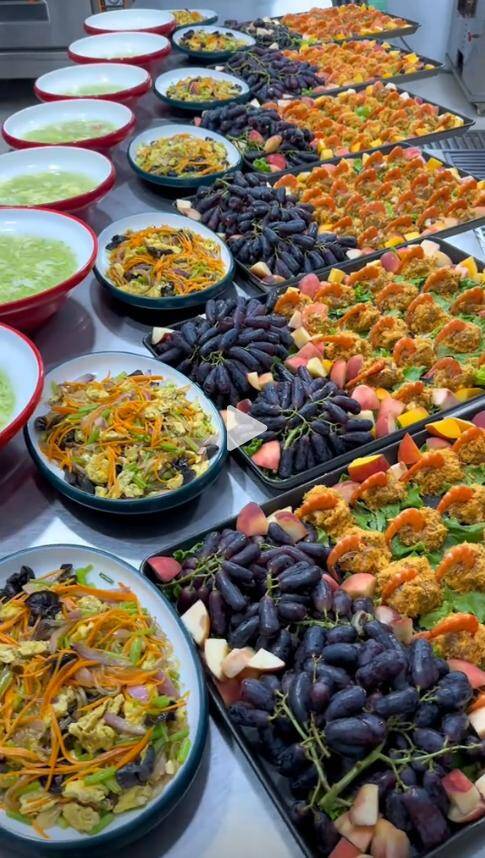Rongxing Kindergarten in Ning’an City, Heilongjiang Province, China, gained online fame after sharing videos and photos of their students’ meals. The menu impressed netizens with its abundance and luxury, featuring dishes comparable to those served in five-star restaurants. Seafood such as shrimp, Alaskan crab, salmon, oysters, eel, and scallops graced the tables, accompanied by fruits like blueberries and grapes, as well as various pasta dishes and snacks.

The online community was curious about the cost of such lavish meals, and many were surprised to learn that the fees were quite reasonable. The kindergarten’s principal shared that the school was established in 2015 and currently has 12 classes with over 200 students. Despite the high-quality meals, the monthly tuition is affordable. “The monthly tuition is 500 RMB, and the food fee is 16 RMB per day (approximately 58,000 VND), including three meals and snacks, which is 352 RMB (nearly 1,300,000 VND) for 22 days a month. So, the total monthly fee for the children is 852 RMB,” said Principal Meng Xueqiao.


Parents of students also praised the school’s kitchen for its cleanliness and organization, with a variety of dishes and utensils for the students’ use. This has given parents peace of mind, knowing that their children are well-cared for during their time at the kindergarten.

In reality, as mentioned earlier, most parents are concerned about their children’s lunch at school. However, parents can rest assured that their children are in good hands when it comes to having lunch at school. Eating at school has several benefits for children. Both children and parents save time on commuting and have more time to rest, socialize, and develop various life skills.
Additionally, parents can be confident that their children are likely to enjoy school lunches and find them tasty due to the following reasons:
– Competitive atmosphere with peers
At home, children are often surrounded by toys and the television, which can distract them from their meals. Parents may try to force their children to eat, thinking they are hungry, but this approach takes away the joy of eating and may make them less inclined to eat.
In contrast, the atmosphere in elementary schools is vibrant and full of peers of the same age. This social setting naturally stimulates children’s appetite and makes mealtimes more enjoyable.
Teachers also use encouragement and rewards to motivate children to eat. For example, they may praise students who eat diligently and quickly in front of the class and offer small prizes. This incentivizes other children to improve their eating habits.
– Appropriate portion sizes
Some children are small in stature, and parents may try to overfeed them to promote weight gain. This can lead to an unhealthy relationship with food and cause children to become tired of eating.
In elementary schools, teachers may monitor children’s eating habits, but there is no pressure to finish everything on their plates. Additionally, seeing their peers eat foods they may not typically enjoy at home can spark curiosity and encourage them to try new things. This approach allows children to develop a healthier relationship with food and fosters a sense of adventure in their eating habits.
– Faster onset of hunger
Many parents provide their children with snacks throughout the day. Constant snacking can reduce a child’s appetite and make it difficult for them to feel hungry during mealtimes.
In elementary schools, teachers follow a structured schedule for meals, playtime, and naps. With increased physical activity and energy expenditure during classes, children are more likely to feel hungry and eat well during designated mealtimes. Additionally, schools can help control snacking habits, ensuring that children eat properly during mealtimes.
In conclusion, it is essential for parents and schools to work together to provide children with safe and convenient lunch options. This collaboration ensures that children look forward to going to school each day and sets them up for a lifetime of healthy eating habits.
The Blue Zones: Unveiling the Secrets to Longevity
Have you ever wondered about the secrets to longevity in the world’s Blue Zones? These are regions where people live not just long, but also healthy and happy lives. Join us as we uncover three unique lifestyle factors that set these populations apart and could potentially extend your lifespan, enhancing your overall quality of life.
Unveiling the 6 Ultimate Tips for a Healthy and Happy Toddler’s Appetite this Tet Holiday
The Lunar New Year is a time for family reunions, but it can also be a challenge for parents to ensure their children maintain a balanced and nutritious diet. With the festivities in full swing, how can parents ensure their little ones eat well, stay healthy, and avoid common illnesses during this busy time?






































